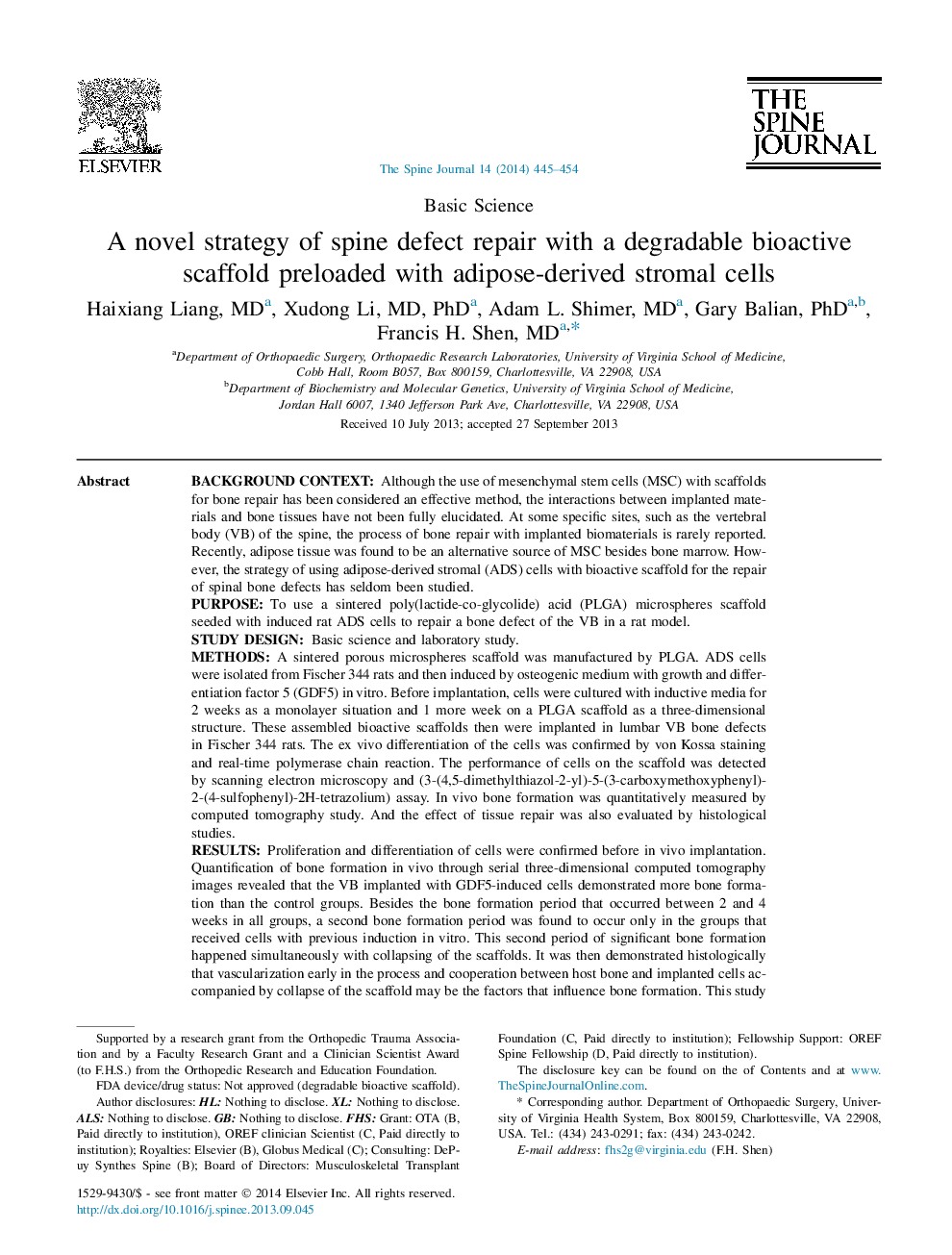| کد مقاله | کد نشریه | سال انتشار | مقاله انگلیسی | نسخه تمام متن |
|---|---|---|---|---|
| 4097872 | 1268602 | 2014 | 10 صفحه PDF | دانلود رایگان |
Background contextAlthough the use of mesenchymal stem cells (MSC) with scaffolds for bone repair has been considered an effective method, the interactions between implanted materials and bone tissues have not been fully elucidated. At some specific sites, such as the vertebral body (VB) of the spine, the process of bone repair with implanted biomaterials is rarely reported. Recently, adipose tissue was found to be an alternative source of MSC besides bone marrow. However, the strategy of using adipose-derived stromal (ADS) cells with bioactive scaffold for the repair of spinal bone defects has seldom been studied.PurposeTo use a sintered poly(lactide-co-glycolide) acid (PLGA) microspheres scaffold seeded with induced rat ADS cells to repair a bone defect of the VB in a rat model.Study designBasic science and laboratory study.MethodsA sintered porous microspheres scaffold was manufactured by PLGA. ADS cells were isolated from Fischer 344 rats and then induced by osteogenic medium with growth and differentiation factor 5 (GDF5) in vitro. Before implantation, cells were cultured with inductive media for 2 weeks as a monolayer situation and 1 more week on a PLGA scaffold as a three-dimensional structure. These assembled bioactive scaffolds then were implanted in lumbar VB bone defects in Fischer 344 rats. The ex vivo differentiation of the cells was confirmed by von Kossa staining and real-time polymerase chain reaction. The performance of cells on the scaffold was detected by scanning electron microscopy and (3-(4,5-dimethylthiazol-2-yl)-5-(3-carboxymethoxyphenyl)-2-(4-sulfophenyl)-2H-tetrazolium) assay. In vivo bone formation was quantitatively measured by computed tomography study. And the effect of tissue repair was also evaluated by histological studies.ResultsProliferation and differentiation of cells were confirmed before in vivo implantation. Quantification of bone formation in vivo through serial three-dimensional computed tomography images revealed that the VB implanted with GDF5-induced cells demonstrated more bone formation than the control groups. Besides the bone formation period that occurred between 2 and 4 weeks in all groups, a second bone formation period was found to occur only in the groups that received cells with previous induction in vitro. This second period of significant bone formation happened simultaneously with collapsing of the scaffolds. It was then demonstrated histologically that vascularization early in the process and cooperation between host bone and implanted cells accompanied by collapse of the scaffold may be the factors that influence bone formation. This study not only provides a therapeutic strategy of using biomaterial for bone repair in the spine, but also may lead to a technological method for studying the relationship between implanted stem cells and host tissue.ConclusionsAdipose-derived stromal cells maintained in culture on a scaffold and treated with osteogenic induction with growth factor ex vivo could be used to enhance bone repair in vivo.
Journal: The Spine Journal - Volume 14, Issue 3, 1 March 2014, Pages 445–454
